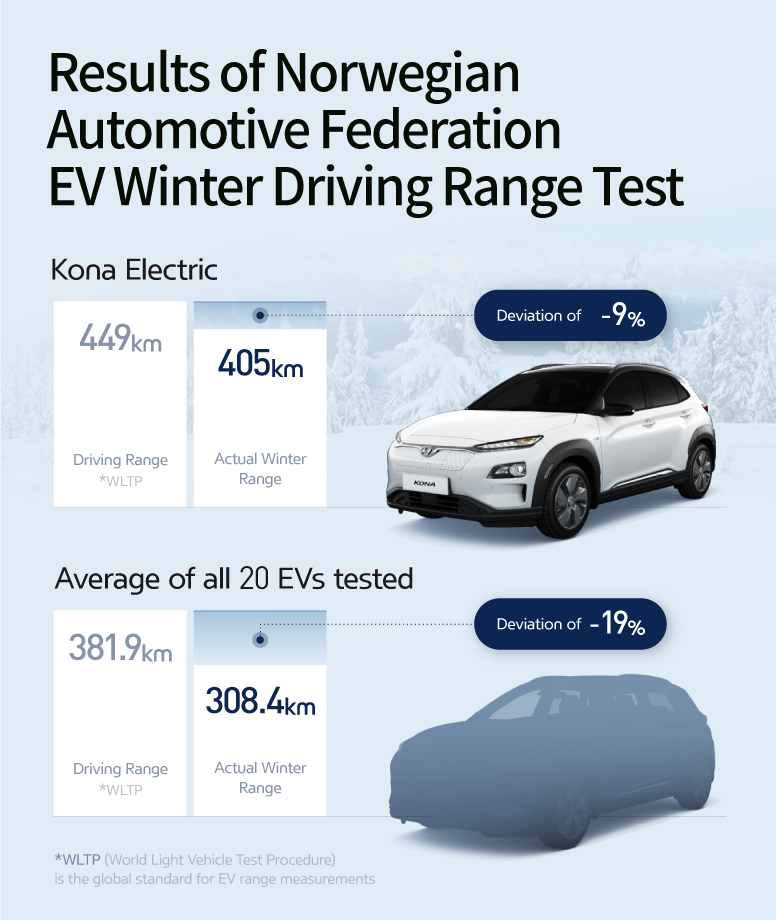Norwegians tested the 20 of the best-selling EVs in the country to figure out which one’s the best.
The all-electric segment market share was 42.4% in Norway, which makes almost half in the world, considering EVs take only 2.5% of global vehicle sales. This means that Norway has more EVs than any other country.
The Norwegian Automotive Federation (NAF) recently compared 20 EVs in cold and warm weather conditions to identify models with the most consistent driving range and charging performance. The test monitored the performance deviation of each vehicle in cold conditions compared to quoted manufacturer figures.
Best-selling EVs, such as the Hyundai Kona Electric, Volkswagen e-Golf, Nissan Leaf, Tesla Model S, Mercedes-Benz EQC, and so on, were tested at the temperature of -2 degrees Celcius. They were driven until they stopped completely and shut down, to measure their real-world range.

The Kona Electric took first place, travelling 405km in the cold – compared to the 449km quoted under WLTP combined cycle testing conditions (23°C / 73°F). In severe cold weather, the Kona Electric offered 91 percent of its WLTP combined cycle range, deviating just 9 percent from its claimed all-electric driving range.
The Tesla Model S Long Range(LR) has the longest WLTP range on the market. In the real-life range test, the Model S went the furthest(470 km). The Tesla Model S LR managed only 74 percent of the stated WLTP range. Ioniq Electric, on the other hand, traveled 279 km in the cold, compared to the stated WLTP range – 311 km, marking just a 10 percent difference.

NAF called Kona Electric “an EV closest to its own stated WLTP range”. With the cabin temperature set to 21 degrees Celcius and the seat heater on, it ran 405 km including 14 kilometers of ‘Power-saving Mode’. The average energy consumption marked 15.3kWh/100km, showing just 0.1kWh difference from its official specs.

The industry-leading heat pump technology has been developed further for new EVs from Hyundai and Kia. It now harvests significantly more energy by recycling additional waste heat not only from power electrics (PE) modules (such as electric motors, on-board chargers, and inverters), but also from the battery pack and slow charger. The system uses the heat generated by these components to vaporize refrigerant from liquid to gas form. High-pressure gas is discharged from the compressor and forced into a condenser to be converted back into a liquid. This process generates additional heat energy that is recovered by the heat pump and used to warm the cabin.

Kona Electric proved itself to be extremely competitive when it comes to rapid charging in cold weather. All the cars charged from less than 10 percent to a minimum of 80 percent. And NAF said Kona Electric spent 55 minutes – just one minute longer than the official charging time – charging the battery from 10% to 80%. This was definitely an EV closest to its own stated WLTP range.

Kona Electric has been acknowledged as the Best Small Family Car in the inaugural TopGear Electric Awards, after it completed a 1,600-kilometers road trip across 9 European countries. Hyundai Motor’s fully electric SUV was not only commended for its efficiency and long-distance capability but also for its smooth and effortless performance.

The 24-hour-long drive took place in December 2019, with BBC TopGear magazine’s Editor-in-Chief Charlie Turner using the European rapid charger network to supply the Kona Electric with 316kWh of electricity, choosing to only charge to 80% capacity in order to maximise driving time. In total 9 countries were visited with the trip starting in the Czech Republic and the 1,600-kilometre drive taking in Germany, Austria, Switzerland, Lichtenstein, France, Luxembourg, Belgium and Holland. Turner said, “we’ve proved that range anxiety shouldn’t play a part in long-distance travel.”

Recent upgrades of the Hyundai Kona Electric 2020 have been estimated to enhance its residual value, according to new data published by the independent RV guidebook Autovista Intelligence. Among the European markets, Kona Electric (3yrs/60,000 km) is predicted to maintain on average 47.2 percent of its original value. Respective data was collected in Germany(49%, 2nd), the UK(59.7%, 1st), Spain(41.9%, 2nd), and Italy(48%, 1st). The data also shows that Kona Electric is predicted to have one of the leading residual values compared to key EV competitors such as Peugeot e-208, Opel/ Vauxhall Corsa-e, or BMW i3.

Kona Electric won one of the ten spots in the 2019 WardsAuto 10 Best Engine competition, named the winner of the 2019 North American Utility Vehicle of the Year, Affordable Electric Car of the Year at the Auto Express New Car Awards, and many others.
